2. 中国环境科学研究院, 环境基准与风险评估国家重点实验室, 北京 100012;
3. 中国环境科学研究院流域水生态保护技术研究室, 北京 100012;
4. 大连海洋大学水产与生命学院, 大连 116023
2. State Key Laboratory of Environmental Criteria and Risk Assessment, Chinese Research Academy of Environmental Sciences, Beijing 100012, China;
3. Laboratory of Riverine Ecological Conservation and Technology, Chinese Research Academy of Environmental Sciences, Beijing 100012, China;
4. College of Fisheries and Life Science, Dalian Ocean University, Dalian 116023, China
微型浮游生物通常指的是粒径小于20 μm的浮游生物[1], 是能量流动和物质循环的重要环节[2, 3], 在海洋生态系统中占有重要的地位.近年来, 黄海面临着严重的营养盐污染问题, 以氮为例, 每年有11 Gmol·a-1的氮在水体中积累, 使得氮浓度升高0.6 μmol·(L·a)-1[4].另外, 富营养化导致该海域多次暴发浒苔绿潮[5~7]、赤潮[8, 9]、水母[10, 11]等灾害.微型真核浮游生物是微型食物链的基础, 分析微型真核浮游生物的群落结构对探讨这些灾害的生态影响具有重要的意义[12, 13].关于该海域微型浮游生物的研究多采用流式细胞仪技术[14, 15], 主要偏向于聚球藻、原绿球藻、异养细菌等的研究, 但该技术所能揭示的浮游生物类群较少, 难以区分种属.
高通量测序技术由于其通量高, 可以发现更多新的物种, 在生物多样性研究中应用广泛[16~20]. Malviya等[18]通过高通量测序的办法, 分析了全球范围内不同粒径硅藻的分布特征, 同时对比高通量测序方法与显微镜方法所得到的物种, 发现高通量测序方法得到的物种数要远高于显微镜的方法, 而且发现了更多新的种类.王靖淇等[19]通过对比光学显微镜与高通量测序所得到的辽河真核浮游藻类, 发现后者检测到许多显微镜未观察到的类群, 如轮藻门、隐藻门、定鞭藻门等. Mueller等[20]采用高通量测序技术分析亚马逊热带雨林不同土地利用类型的生境中土壤真菌的群落结构, 发现土地利用类型显著影响土壤真菌群落结构, 而这种影响与植物群落结构有很大的关联性.
目前运用高通量测序技术研究浮游生物群落的标记性基因主要包括核糖体基因(ribosomal DNA, rDNA)、二磷酸核酮糖羧化酶大亚基基因(rbcL)和细胞色素C氧化酶第1亚基基因(cox1).其中核糖体基因中的内转录间隔区(internal transcribed space, ITS), 由于其进化速度快, 具有特异性, 在不同物种间表现有明显差异性, 广泛应用于浮游植物[21, 22]、真菌[23, 24]、浮游动物[25, 26]等的研究. Geml等[24]以ITS为扩增子, 分析了欧洲西部海岸沙丘地带土壤真菌的群落结构, 并探讨了其丰富度及OTUs与土壤pH之间的关系, 发现随着土壤pH的升高, 真菌的丰富度及OTUs呈现出下降的趋势.李玉龙等[26]结合18S及ITS, 对辽东湾水域霞水母进行了物种甄别, 发现该海域的霞水母样品为白色霞水母, 并对比18S和ITS两个基因片段在种内和种间的平均遗传距离, 发现ITS基因片段更适合属内种间水平的进化研究. Zhao等[27]以ITS为扩增子, 通过高通量测序发现2007~2013年黄海暴发浒苔绿潮时, 海域上的漂浮浒苔形成了独特的生态型, 其与潮间带浒苔具有种间差异性.
本研究以ITS为扩增片段, 应用高通量测序技术, 揭示黄海微型真核浮游生物的群落结构及多样性, 分析其空间分布特征及与环境因子, 如:温度、盐度、纬度、海岸线的距离等的关系, 以期为进一步探讨微型真核浮游生物在海洋生态系统中的功能提供理论依据.
1 材料与方法 1.1 样品采集2016年8月于黄海及杭州湾以东海域布置32个采样点位, 分布于北黄海(A-1、A-2、A-3、A-4、A-5、A-6)、冷水团(B-1、B-2、B-3、B-4、B-5)、南黄海(C-1、C-2、C-3、C-4、C-5、C-6、C-7、C-8、C-9)和东海北部(D-1、D-2、D-3、D-4、D-5、D-6、D-7、D-8、D-9、D-10、D-11、D-12).每个点位各采集表层(0~2 m)海水3次, 每次采集4 L, 混合后取3 L用于后续操作.使用孔径为200 μm的纱绢进行过滤, 去除颗粒较大的悬浮物; 通过20 μm的聚碳酸酯膜(Millipore, USA)过滤(P<0.03 MPa), 2 h内完成.将过滤好的膜置于无菌冻存管中, 液氮保存, 干冰运输.采样点详见图 1.
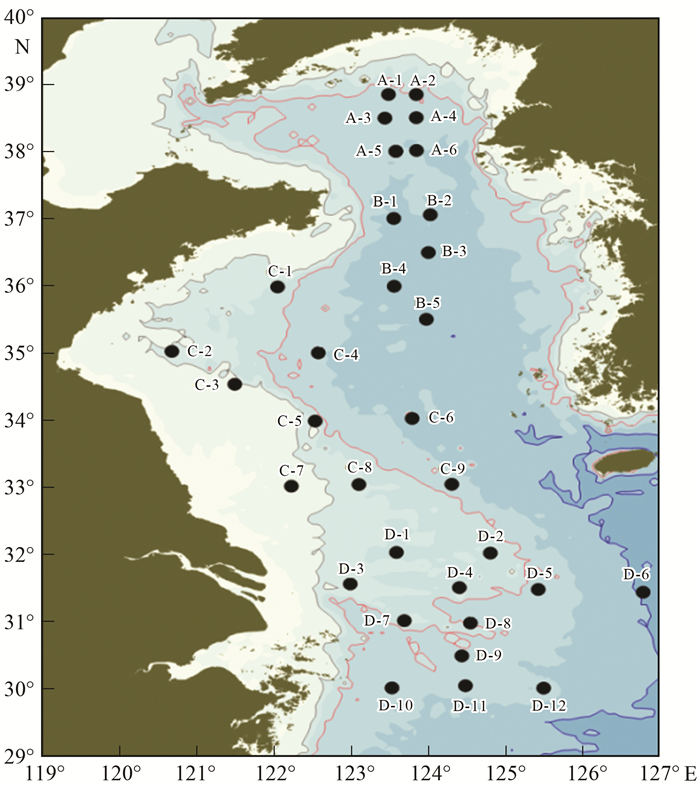
|
图 1 黄海采样点分布示意 Fig. 1 Location of sampling sites in the Yellow Sea |
将冻存管中的滤膜转移至2 mL无菌离心管中, 通过DNA裂解液裂解、蛋白酶K酶解、FastPrep-5G破碎仪(MP Biomedicals, USA)破碎等方法破碎样品, 依据Yuan等[28]采取的方法提取、纯化样品中的DNA.使用Nano Drop 2000(Thermo Fisher Scientific, USA)检测DNA样品的浓度, 并通过0.8%琼脂糖凝胶电泳检测DNA的完整性.
1.3 PCR扩增及Illumina测序以每个样品的DNA原液(50 ng)为模板, 对ITS区进行PCR扩增, 采用的引物为真核生物通用引物, F:5′-GTGAATCATCGARTC-3′, R:5′-TCCTC CGCTTATTGAT-3′, 引物由GENEWIZ公司设计合成. PCR反应条件为:96℃预变性3 min; 96℃变性30 s, 50℃退火30 s, 72℃延伸90 s, 共35个循环; 72℃延伸7 min; 4℃保存. PCR产物的纯化、浓度检测参考文献[23].针对ITS进行高通量文库构建并进行Illumina测序(苏州金唯智生物科技有限公司).
1.4 数据处理ITS序列分析:使用QIIME(quantitative insights into microbial ecology)软件对ITS原始序列过滤, 通过拼接、去引物、去接头、去嵌合体、剔除含有N及低质量得分的序列等方法, 得到高质量的序列.为了减少测序深度造成的误差, 在每个样本中随机抽取37765条高质量序列进行后续的分析.应用软件VSEARCH 1.9.6对高质量序列在97%的相似性水平上进行聚类, 产生可操作性分类单元(operational taxonomic units, OTUs).以每个OTUs中最长的序列作为代表性序列, 通过BLAST在NCBI数据库中查找同源序列, 将最相近且可信度达到80%以上序列的种属信息[29], 作为该OTUs的物种注释信息.
利用Mothur软件构建稀释性曲线, 并计算Ace指数、Chao1指数、Shannon指数、Simpson指数.通过条形图分析门、纲、目水平上各点位的群落分布状况.为分析微型浮游生物的空间分布特征, 将微型真核浮游生物划分为3个类群(真菌、浮游植物、浮游动物), 并研究其在北黄海、冷水团、南黄海、东海北部的群落结构.通过散点图分析环境因子(温度、盐度、纬度、与海岸线的距离)对微型真核浮游生物群落结构的影响.其中条形图、箱体图在软件Origin 8.0中进行.散点图、Spearman相关性分析在软件SPSS 19.0中完成.
2 结果与分析 2.1 测序数据分析本次测序共获得4511086条原始序列, 对原始序列进行质量优化.对优化序列进行随机抽样, 每个样本随机抽取37765条高质量序列, 以抽到的序列数与它们所能代表OTUs的数目构建稀释性曲线.各样本OTUs数目随测序数量的增加趋于平缓, 说明测序深度已足够反映样本中OTUs的数量.所有序列在97%的相似性水平上对其进行聚类, 共获得1 035个OTUs.通过BLAST对OTUs的代表性序列进行物种注释, 注释到科水平的OTUs数目占所有OTUs数目的69.18%, 属水平的OTUs数目占65.99%.
2.2 微型真核浮游生物群落结构特征本次采样共获得微型浮游生物23门53纲118目187科296属, 将注释后的OTUs分别在门、纲、目水平上进行分析(图 2), 可以看出在不同的分类水平上, 各采样点浮游生物的群落结构存在差异.在门这一分类阶元上[图 2(a)], 不同点位的浮游生物种类不同, 而且浮游生物各门的相对丰度也存在差异.例如, 点位A-1中子囊菌门(Ascomycota)、担子菌门(Basidiomycota)和绿藻门(Chlorophyta)的reads数较多, 点位B-3的子囊菌门(Ascomycota)、定鞭金藻门(Haptophyta)及刺胞动物门(Cnidaria) reads数较丰富, 而点位C-7中子囊菌门(Ascomycota)、担子菌门(Basidiomycota)及刺胞动物门(Cnidaria)的reads数所占比例较大.总体看来, 各采样点均有不同比例的子囊菌门(Ascomycota)、担子菌门(Basidiomycota)及刺胞动物门(Cnidaria)的分布.在纲分类阶元上[图 2(b)], 各点位浮游生物的分布也存在较大的差异性.例如, 点位A-4中绿枝藻纲(Prasinophyceae)的reads数占该点位所有reads数的70%以上, 而点位B-4中酵母菌纲(Saccharomycetes)及点位D-1和D-7中伞菌纲(Agaricomycetes)的reads均达到其点位reads数的80%以上.在目分类阶元上[图 2(c)], 不同点位相对丰度较高的浮游生物是不同的, 而且同一目水平的浮游生物在不同点位相对丰度也存在差异性.例如, 旗口水母目(Semaeostomeae) reads数在点位B-5中占该点位所有reads数的50%左右, 而在点位D-12中仅占到10%;四爿藻目(Tetraselmidales) reads数在点位D-3中占5%左右, 而在点位C-3中占到50%.
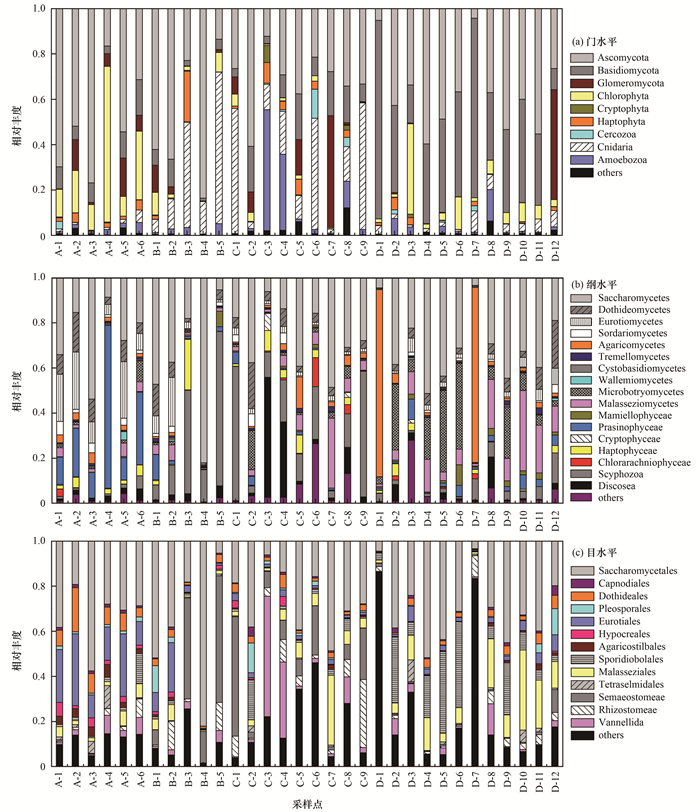
|
图 2 黄海各采样点微型真核浮游生物在门、纲、目水平上的分布情况 Fig. 2 Proportion of micro-plankton in sampling sites in the Yellow Sea at phylum, class and order levels |
另外, 本研究中发现各点位可以被注释的OTUs与不能被注释的OTUs在reads数上存在着较大的差异(图 3).其中, 点位B-2与点位C-8不能被注释OTUs的reads数达到了30 000条, 点位C-4为20 000条, 点位B-3、C-3、C-5、D-5均达到了10 000条, 其余点位不能注释OTUs的reads数相对较低.另外, 点位A-3、A-5、B-4、B-5、D-12中可以被注释OTUs的reads数均在35 000条以上.

|
图 3 各点位已注释与不能注释OTUs的reads数比较 Fig. 3 Comparison of reads between annotated OTUs and unannotated OTUs at the sampling sites |
本研究中微型浮游生物主要类群为真菌、浮游植物、浮游动物, 对这3个类群的主要属(丰度较高的前10个属)进行分析(图 4), 可以看出不同水域主要属的分布存在差异性.

|
图 4 微型浮游生物不同类群主要属在北黄海、冷水团、南黄海、东海北部的分布特征 Fig. 4 Characteristics of main genera of different groups in the northern Yellow Sea, Cold Water Mass, southern Yellow Sea, and northern East Sea |
真菌不同属在北黄海、冷水团、南黄海、东海北部的分布如图 4(a)所示, 德巴利酵母属(Debaryo-myces, 79.76%)、曲霉属(Aspergillus, 63.09%)、Hortaea(44.06%)在北黄海的分布比例较大; 酵母菌属(Saccharomyces)在冷水团水域的比例高达86.01%;假丝酵母属(Candida, 41.65%)、红酵母属(Rhodotorula, 80.83%)、娄德酵母属(Lodderomyces, 76.64%)、马拉色氏霉菌属(Malassezia, 67.95%)、胶膜菌属(Tulasnella, 93.25%)、Yamadazyma (51.76%)主要分布在东海北部.
浮游植物不同属在北黄海、冷水团、南黄海、东海北部的分布如图 4(b)所示, 塔胞藻属(Pyramimonas)在北黄海的分布比例较大, 为39.43%;等鞭金藻属(Isochrysis)主要存在于冷水团水域, 所占比例为47.53%;金色藻属(Chrysochromulina, 45.90%)、定鞭金藻属(Prymnesium, 62.99%)、蓝隐藻属(Chroomonas, 68.36%)、Teleaulax (66.23%)在南黄海的比例较大; 四爿藻属(Tetraselmis, 54.22%)、Mantoniella (68.73%)、Cymbomonas (80.51%)、索囊藻属(Choricystis, 99.83%)主要分布于东海北部.
浮游动物不同属在北黄海、冷水团、南黄海、东海北部的分布如图 4(c)所示, Creolimax主要分布于北黄海, 所占比例高达99.62%;霞水母属(Cyanea)主要存在于冷水团水域, 所占比例为48.50%;根口水母属(Rhizostoma, 46.70%)、Vannella(56.51%)、侧花海葵属(Anthopleura, 99.96%)、Lotharella(62.70%)、Platyamoeba(52.00%)、Nausithoe(66.82%)、侧腕水母(Pleurobrachia, 73.63%)在南黄海的比例较高; 哲水蚤属(Calanus)在东海北部的比例较大, 为57.23%.
2.3.2 不同水域微型真核浮游生物丰度及多样性变化特征由图 5可以看出, 表征物种丰度的Ace指数及Chao1指数在4个水域中的变化趋势基本一致, 表现为南黄海>北黄海>东海北部>冷水团, 可以看出南黄海的物种丰度相对较高, 而冷水团水域的物种丰度相对较低, 另外该两个指数在南黄海的范围最大. Simpson指数及Shannon-Wiener指数均反映了群落的多样性变化, 该两个指数在东海北部水域均高于其他3个水域, 呈现出东海北部>北黄海>南黄海>冷水团的变化趋势, 其中冷水团水域微型浮游生物群落多样性水平最低.
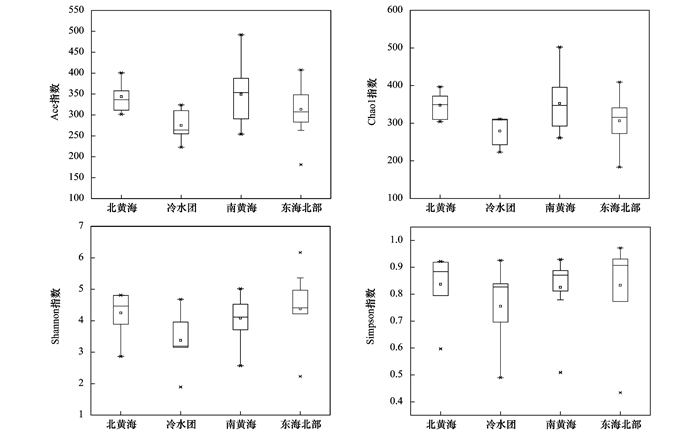
|
图 5 不同水域物种丰度及多样性指数变化 Fig. 5 Variation of species abundance and diversity index in different waters |
相关性分析表明(表 1和图 6), 真菌、浮游植物、浮游动物的reads数与温度都表现出了正相关, 说明在20~34℃范围内, 随着温度的升高, 真菌、浮游植物、浮游动物的reads数均呈现出增加的趋势.此外, 随着温度的上升, 真菌、浮游植物、浮游动物的OTUs也呈现出上升的变化趋势.
|
|
表 1 真菌、浮游植物、浮游动物reads数及OTUs与温度、盐度的相关性1) Table 1 Correlation between reads and OTUs of fungi, phytoplankton, and zooplankton and temperature and salinity |
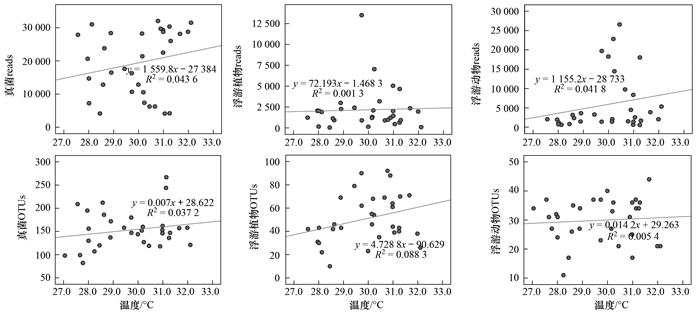
|
图 6 真菌、浮游植物、浮游动物reads数及OTUs与温度的相关性 Fig. 6 Correlation between temperature and reads and OTUs of fungi, phytoplankton, and zooplankton |
分别将真菌、浮游植物、浮游动物的reads数及OTUs与盐度进行相关性分析(表 1和图 7), 结果表明浮游植物、浮游动物的reads数均随着盐度的增加而下降, 其中浮游植物的reads数显著下降(P<0.01), 而真菌的reads数则随着盐度的增加而上升.真菌的reads数、OTUs对盐度变化的响应趋势相同, 浮游植物和浮游动物亦然.
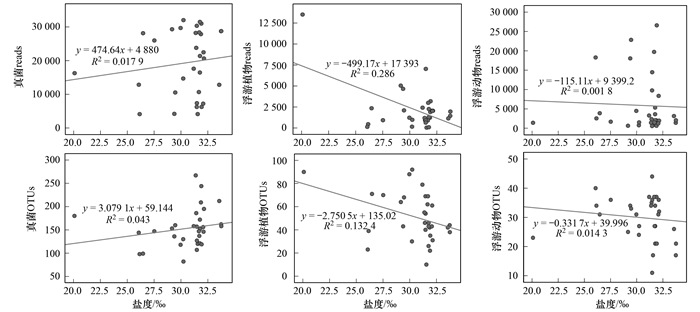
|
图 7 真菌、浮游植物、浮游动物reads数及OTUs与盐度的相关性 Fig. 7 Correlation between salinity and reads and OTUs of fungi, phytoplankton, and zooplankton |
相关性分析结果表明(表 2和图 8), 在北纬30°~40°范围内, 随着纬度的升高, 真菌、浮游动物的Shannon-Wiener指数均呈现出上升的趋势, 而浮游植物的Shannon-Wiener指数显著下降(P<0.01).
|
|
表 2 真菌、浮游植物、浮游动物Shannon-Wiener指数与纬度、与海岸线距离的相关性1) Table 2 Correlation between Shannon-Wiener index of fungi, phytoplankton, and zooplankton and latitude and distance from the coast |

|
图 8 真菌、浮游植物、浮游动物多样性指数与纬度的关系 Fig. 8 Relationships between Shannon-Wiener index of fungi, phytoplankton, and zooplankton and latitude |
分别将真菌、浮游植物、浮游动物的Shannon-Wiener指数与距海岸线的距离进行相关性分析(表 2和图 9), 发现该3个类群的Shannon-Wiener指数均随着与海岸线距离的增加而下降, 其中浮游植物Shannon-Wiener指数显著下降(P<0.05).

|
图 9 真菌、浮游植物、浮游动物多样性指数与海岸线距离的关系 Fig. 9 Relationships between Shannon-Wiener index of fungi, phytoplankton, and zooplankton and distance from the coast |
本研究基于ITS区探讨黄海微型浮游生物的群落结构, 发现其主要包括3个类群:真菌、浮游植物、浮游动物, 其中真菌的reads数高达619 594条, OTUs高达4 899个; 浮游植物reads数为69 189条, OTUs为1 635个; 浮游动物reads数为188 378条, OTUs为956个.可以看出, 真菌的reads数和OTUs均显著高于浮游植物、浮游动物, 真菌reads数>浮游动物reads数>浮游植物reads数, 真菌OTUs>浮游植物OTUs>浮游动物OTUs. Bellemain等[23]首次通过大规模扩增ITS区并结合高通量测序技术研究了西伯利亚地区16 000~32 000放射性碳年永久冻土沉积物中真菌的多样性, 发现OTUs中高达75.4%的真菌属于子囊菌门, 同时检测到许多寄生真菌、水生真菌、内生真菌等, 拓展了人们关于真菌多样性的认识. Zhang等[30]首次在ITS区扩增的基础上, 采用454焦磷酸测序技术探讨了北极地区寄生于4种维管束植物茎部和叶部的内生真菌多样性, 提出气候以及与宿主有关的因素均会影响真菌的群落结构.本研究首次采用扩增ITS区的方法, 应用高通量测序技术对黄海真菌的多样性进行了分析.与以往基于ITS区扩增得到的真菌相比, 本研究所得真菌种类丰富, 以子囊菌门、担子菌门、球囊菌门、接合菌门为主, 少量壶菌门.
本研究还获得较丰富的浮游动物种类.在属这一门类上, 霞水母属(Cyanea)、哲水蚤属(Calanus)的丰度较高.霞水母属广泛分布于海洋中, 其生长过程中分泌毒素并粘结网具, 造成海洋渔业资源的枯竭[31], 我国近海暴发的多次大型灾害性水母事件均以该属为主.水母暴发改变了海洋生物群落结构和生态系统的能量传递方式[32], 严重影响了海洋渔业生产, 使得作业渔场范围缩小, 甚至无法正常生产[33].本研究发现霞水母属在冷水团水域、南黄海的分布比例较高, 这与左涛等[34]在2015年5月采用拖网方式获得的霞水母属的分布区域不同, 其研究表明霞水母属主要位于胶州湾以东的东海.本研究首次从环境DNA的角度, 选取特异性强、种间差异性大的ITS作为扩增子, 所获得的霞水母属的分布范围大于以往报道[34~36].哲水蚤属为我国近海及日本沿岸海浮游动物的优势种之一, 本研究中哲水蚤属在东海北部占优势, 这与孙鲁峰等[37]研究得到的分布区域相一致.长江冲淡水加上黄海暖流的作用使得该海域浮游生物量丰富, 种类繁多[38].与真菌、浮游动物比较而言, 本研究获得的浮游植物reads数较低, 以等鞭金藻属、四爿藻属为主, 补充了以往通过显微镜方法观察到的浮游植物种类[39, 40].柳丽华[40]采用显微镜的方法, 分析了黄海春季、秋季浮游植物的种类组成和分布特点, 发现浮游植物以硅藻、甲藻为主, 多为沿岸性广温、广盐性种类; 秋季浮游植物数量明显高于春季, 季节更替明显.研究发现, 黄、东海丰度较高的甲藻门在本研究中并未检测出, 这可能是由于引物具有偏好性, 需要进一步探究.
3.2 不同水域微型真核浮游生物多样性特征研究发现, 不同水域的浮游生物在物种丰度及多样性上均存在着较大的差异, 物种丰度上呈现出南黄海>北黄海>东海北部>冷水团的变化, 而在多样性上4个水域的变化为东海北部>北黄海>南黄海>冷水团.可以看出, 冷水团水域的物种丰度和多样性最低.苏纪兰等[41]曾指出黄海冷水团盛行时, 在垂直方向上存在双环流结构, 跃层以上为中心上升、边缘下降的弱环流, 跃层以下为中心下降、边缘上升的强环流.由于冷水团内部环流的扰动作用, 使得次表层至底层的营养盐丰富, 而表层营养盐浓度较低, 这可能是导致表层物种丰度和多样性出现低值的重要原因.
吕末晓等[39]2014年8月在该海域进行采样研究时发现, 在长江口以东123°E附近海域的表层水体中, 浮游植物的物种丰富度及多样性程度均显著高于其他海域. 2015年5月左涛等[34]针对该海域多次发生的水母暴发事件, 对其种类数量进行了研究, 提出5月大型水母的分布具有地理区域性, 黄海中部的生物量最高.与本研究的浮游生物多样性及丰度较高区域具有一致性.
3.3 环境因子对微型浮游生物分布的影响本研究主要探讨了温度、盐度、纬度、与海岸线的距离这4个环境因子对微型浮游生物空间分布及物种丰度、多样性的影响.温度、盐度是调控微型浮游生物分布的重要环境因子[42].研究发现, 随着温度的升高, 真菌、浮游植物、浮游动物reads数均呈现出上升的趋势, 这与屈佩[14]在研究南黄海秋季微微型浮游生物对温度的响应得到的结论相同.随着盐度的增加, 真菌的reads数、OTUs表现出上升的趋势, 而浮游植物、浮游动物的reads数、OTUs下降.崔世开等[43]在研究夏季北极黄河站附近的王湾海域浮游植物群落对盐度的响应关系时, 发现低稀释率的盐度促进浮游植物的生长, 而屈佩[14]提出不同的季节浮游植物对盐度的响应不同, 秋季浮游植物的物种丰度随着盐度的升高而下降.李洁[44]以自养微型鞭毛虫和异养微型鞭毛虫为例, 探讨分析了其丰度和生物量与盐度之间的关系, 提出不同月份两者之间的关系不同, 2013年6月表层自养微型鞭毛虫与异养微型鞭毛虫的丰度和生物量均与盐度呈显著负相关关系, 而在8月自养微型鞭毛虫与异养微型鞭毛虫的丰度和生物量均与盐度无显著相关关系.李灼等[45]通过分析南海北部微型浮游动物的群落结构及与环境因子之间的关系, 发现盐度是影响微型浮游动物丰度的一个重要因素, 而且不同物种对盐度的响应关系不同, 如简单伪曳尾虫的丰度随着盐度的升高而减小, 而放射虫的丰度随着盐度的升高而增加.有关真菌丰度和多样性与盐度之间关系的研究尚未见报道, 需要进一步探讨两者之间的关系.
本研究分析了真菌、浮游植物、浮游动物3个类群的Shannon-Wiener指数与纬度的关系, 发现在北纬30°~40°范围内, 该3个类群Shannon-Wiener指数与纬度的关系存在差异性, 真菌、浮游动物多样性指数随纬度的升高均呈现上升的趋势, 而浮游植物多样性指数呈现下降的趋势. Malviya等[18]以10°为间隔, 将采样点的纬度范围0°~60°划分为6段, 并分析了硅藻多样性指数随纬度升高的变化趋势, 发现随着纬度的升高, 硅藻多样性指数呈现出下降的趋势.与海岸线的距离是影响微型浮游生物丰度及多样性的另一重要因素. Malviya等[18]认为硅藻的多样性程度与距海岸线的距离有着重要关系, 随着距离的增大, 多样性水平降低.本研究中同样发现微型浮游生物多样性的变化受与海岸线的距离这一因素的影响, 而且真菌、浮游植物、浮游动物的多样性均随着与海岸线距离的增大而降低.
4 结论(1) 基于ITS的高通量测序技术可获得较丰富的真菌、浮游植物、浮游动物种类数, 其中真菌reads数>浮游动物reads数>浮游植物reads数, 真菌OTUs>浮游植物OTUs>浮游动物OTUs.
(2) 不同水域微型浮游生物的物种丰度及多样性程度不同, Ace指数及Chao1指数表现为南黄海>北黄海>东海北部>冷水团, Simpson指数及Shannon-Wiener指数表现为东海北部>北黄海>南黄海>冷水团, 冷水团水域的物种丰度及多样性最低.
(3) 随着温度的升高, 真菌、浮游植物、浮游动物reads数、OTUs均呈现出上升的趋势; 随着盐度的增加, 真菌、浮游动物的reads数、OTUs升高, 而浮游植物的reads数、OTUs显著下降; 在北纬30°~40°范围内, 随着纬度的升高, 真菌、浮游动物Shannon-Wiener指数上升, 浮游植物Shannon-Wiener指数下降; 与海岸线的距离越大, 真菌、浮游植物、浮游动物Shannon-Wiener指数越低.
| [1] | Sieburth J M, Smetacek V, Lenz J, et al. Pelagic ecosystem structure:heterotrophic compartments of the plankton and their relationship to plankton size fractions[J]. Limnology and Oceanography, 1978, 23(6): l256-1263. |
| [2] | Falkowski P G, Fenchel T, Delong E F. The microbial engines that drive Earth's biogeochemical cycles[J]. Science, 2008, 320(5879): 1034-1039. DOI:10.1126/science.1153213 |
| [3] | DeLong E F. The microbial ocean from genomes to biomes[J]. Nature, 2009, 459(7244): 200-206. DOI:10.1038/nature08059 |
| [4] |
赵晨英, 臧家业, 刘军, 等. 黄渤海氮磷营养盐的分布、收支与生态环境效应[J]. 中国环境科学, 2016, 36(7): 2115-2127. Zhao C Y, Zang J Y, Liu J, et al. Distribution and budget of nitrogen and phosphorus and their influence on the ecosystem in the Bohai Sea and Yellow Sea[J]. China Environmental Science, 2016, 36(7): 2115-2127. |
| [5] | Liu X Q, Wang Z L, Zhang X L. A review of the green tides in the Yellow Sea, China[J]. Marine Environmental Research, 2016, 119: 189-196. DOI:10.1016/j.marenvres.2016.06.004 |
| [6] | Zhou M J, Liu D Y, Anderson D M, et al. Introduction to the special issue on green tides in the Yellow Sea[J]. Estuarine, Coastal and Shelf Science, 2015, 163: 3-8. DOI:10.1016/j.ecss.2015.06.023 |
| [7] | Li Y, Song W, Xiao J, et al. Tempo-spatial distribution and species diversity of green algae micro-propagules in the Yellow Sea during the large-scale green tide development[J]. Harmful Algae, 2014, 39: 40-47. DOI:10.1016/j.hal.2014.05.013 |
| [8] | Du X J, Shao F J, Wu S Y, et al. Complex network modeling for mechanisms of red tide occurrence:a case study in Bohai Sea and North Yellow Sea of China[J]. Ecological Modelling, 2017, 361: 41-48. DOI:10.1016/j.ecolmodel.2017.07.025 |
| [9] |
刘录三, 李子成, 周娟, 等. 长江口及其邻近海域赤潮时空分布研究[J]. 环境科学, 2011, 32(9): 2497-2504. Liu L S, Li Z C, Zhou J, et al. Temporal and spatial distribution of red tide in Yangtze River Estuary and adjacent waters[J]. Environmental Science, 2011, 32(9): 2497-2504. |
| [10] |
丁峰元, 程家骅. 东海区夏、秋季大型水母分布区渔业资源特征分析[J]. 海洋渔业, 2005, 27: 120-128. Ding F Y, Cheng J H. The analysis on fish stock characteristics in the distribution areas of large jellyfish during summer and autumn in the East China Sea region[J]. Marine Fisheries, 2005, 27(2): 120-128. |
| [11] | Wei H, Deng L J, Wang Y H, et al. Giant jellyfish Nemopilema nomurai gathering in the Yellow Sea-a numerical study[J]. Journal of Marine Systems, 2015, 144: 107-116. DOI:10.1016/j.jmarsys.2014.12.001 |
| [12] | Lovejoy C, Massana R, Pedrós-Alió C. Diversity and distribution of marine microbial eukaryotes in the Arctic Ocean and adjacent seas[J]. Applied and Environmental Microbiology, 2006, 72(5): 3085-3095. DOI:10.1128/AEM.72.5.3085-3095.2006 |
| [13] | Lovejoy C, Vincent W F, Bonilla S, et al. Distribution, phylogeny, and growth of cold-adapted picoprasinophytes in Arctic seas[J]. Journal of Phycology, 2007, 43(1): 78-89. DOI:10.1111/jpy.2007.43.issue-1 |
| [14] |
屈佩. 南黄海微微型浮游生物时空分布及主要影响因素研究——基于流式细胞技术[D]. 青岛: 中国海洋大学, 2013. Qu P. The distribution of picoplankton communities in the southern Yellow Sea-The investigation basing on flow cytometry[D]. Qingdao: Ocean University of China, 2013. http://cdmd.cnki.com.cn/Article/CDMD-10423-1013348293.htm |
| [15] |
赵苑. 黄海和东海微微型浮游生物分布研究[D]. 青岛: 中国海洋大学, 2010. Zhao Y. Spatial and temporal distribution of picoplankton in Yellow Sea and East China Sea[D]. Qingdao: Ocean University of China, 2010. http://cdmd.cnki.com.cn/article/cdmd-10423-1011029998.htm |
| [16] | Liu L M, Yang J, Lv H, et al. Phytoplankton communities exhibit a stronger response to environmental changes than bacterioplankton in three subtropical reservoirs[J]. Environmental Science & Technology, 2015, 49(18): 10850-10858. |
| [17] | Yu Z, Yang J, Liu L M, et al. Bacterioplankton community shifts associated with epipelagic and mesopelagic waters in the Southern Ocean[J]. Scientific Reports, 2015, 5: 12897. DOI:10.1038/srep12897 |
| [18] | Malviya S, Scalco E, Audic S, et al. Insights into global diatom distribution and diversity in the world's ocean[J]. Proceedings of the National Academy of Sciences of the United States of America, 2016, 113(11): E1516-E1525. DOI:10.1073/pnas.1509523113 |
| [19] |
王靖淇, 王书平, 张远, 等. 高通量测序技术研究辽河真核浮游藻类的群落结构特征[J]. 环境科学, 2017, 38(4): 1403-1413. Wang J Q, Wang S P, Zhang Y, et al. Community structure characteristics of eukaryotic planktonic algae in Liaohe River through high-throughput sequencing[J]. Environmental Science, 2017, 38(4): 1403-1413. |
| [20] | Mueller R C, Paula F S, Mirza B S, et al. Links between plant and fungal communities across a deforestation chronosequence in the Amazon rainforest[J]. The ISME Journal, 2014, 8(7): 1548-1550. DOI:10.1038/ismej.2013.253 |
| [21] | Saunders G W, Kucera H. An evaluation of rbcL, tufA, UPA, LSU and ITS as DNA barcode markers for the marine green macroalgae[J]. Cryptogamie Algologie, 2010, 31(4): 487-528. |
| [22] | Duan W J, Guo L X, Sun D, et al. Morphological and molecular characterization of free-floating and attached green macroalgae Ulva spp. in the Yellow Sea of China[J]. Journal of Applied Phycology, 2012, 24(1): 97-108. DOI:10.1007/s10811-011-9654-7 |
| [23] | Bellemain E, Davey M L, Kauserud H, et al. Fungal palaeodiversity revealed using high-throughput metabarcoding of ancient DNA from arctic permafrost[J]. Environmental Microbiology, 2013, 15(4): 1176-1189. DOI:10.1111/emi.2013.15.issue-4 |
| [24] | Geml J, Gravendeel B, van der Gaag K J, et al. The contribution of DNA metabarcoding to fungal conservation:diversity assessment, habitat partitioning and mapping red-listed fungi in protected coastal Salix repens communities in the Netherlands[J]. PLoS One, 2014, 9(6): e99852. DOI:10.1371/journal.pone.0099852 |
| [25] | Li R F, Yu H H, Yang Y, et al. Combined proteomics and transcriptomics identifies sting-related toxins of jellyfish Cyanea nozakii[J]. Journal of Proteomics, 2016, 148: 57-64. DOI:10.1016/j.jprot.2016.07.023 |
| [26] |
李玉龙, 董婧, 王彬, 等. 基于18S和ITS-5.8S rDNA基因序列的白色霞水母(Cyanea nozakii)的分子鉴定与检测[J]. 海洋与湖沼, 2016, 47(1): 158-165. Li Y L, Dong J, Wang B, et al. Molecular identification and detection of Cyanea nozakii by partial sequencing of 18S rDNA and ITS-5.8S[J]. Oceanologia et Limnologia Sinica, 2016, 47(1): 158-165. |
| [27] | Zhao J, Jiang P, Qin S, et al. Genetic analyses of floating Ulva prolifera in the Yellow Sea suggest a unique ecotype[J]. Estuarine, Coastal and Shelf Science, 2015, 163: 96-102. DOI:10.1016/j.ecss.2015.05.027 |
| [28] | Yuan J, Li M Z, Lin S J. An improved DNA extraction method for efficient and quantitative recovery of phytoplankton diversity in natural assemblages[J]. PLoS One, 2015, 10(7): e0133060. DOI:10.1371/journal.pone.0133060 |
| [29] | Liu L M, Yang J, Yu Z, et al. The biogeography of abundant and rare bacterioplankton in the lakes and reservoirs of China[J]. The ISME Journal, 2015, 9(9): 2068-2077. DOI:10.1038/ismej.2015.29 |
| [30] | Zhang T, Yao Y F. Endophytic fungal communities associated with vascular plants in the high Arctic zone are highly diverse and host-plant specific[J]. PLoS One, 2015, 10(6): e0130051. DOI:10.1371/journal.pone.0130051 |
| [31] | Jiang H, Cheng H Q, Xu H G, et al. Trophic controls of jellyfish blooms and links with fisheries in the East China Sea[J]. Ecological Modelling, 2008, 212(3-4): 492-503. DOI:10.1016/j.ecolmodel.2007.10.048 |
| [32] | Shi Y Q, Sun S, Zhang G T, et al. Distribution pattern of zooplankton functional groups in the Yellow Sea in June:a possible cause for geographical separation of giant jellyfish species[J]. Hydrobiologia, 2015, 754(1): 43-58. DOI:10.1007/s10750-014-2070-7 |
| [33] | Sun S, Zhang F, Li C L, et al. Breeding places, population dynamics, and distribution of the giant jellyfish Nemopilema nomurai (Scyphozoa:Rhizostomeae) in the Yellow Sea and the East China Sea[J]. Hydrobiologia, 2015, 754(1): 59-74. DOI:10.1007/s10750-015-2266-5 |
| [34] |
左涛, 王俊, 吴强, 等. 2015年5月黄海及东海北部大型水母分布及生物量估算[J]. 海洋与湖沼, 2016, 47(1): 195-204. Zuo T, Wang J, Wu Q, et al. Spatial distribution and biomass of large jellyfish in the Yellow Sea and northern part of the East China Sea in May 2015[J]. Oceanologia et Limnologia Sinica, 2016, 47(1): 195-204. |
| [35] |
孙松, 于志刚, 李超伦, 等. 黄、东海水母暴发机理及其生态环境效应研究进展[J]. 海洋与湖沼, 2012, 43(3): 401-405. Sun S, Yu Z G, Li C L, et al. Progress in the jellyfish bloom research in the Yellow Sea and East China Sea[J]. Oceanologia et Limnologia Sinica, 2012, 43(3): 401-405. |
| [36] |
丁军军. 黄东海微小型浮游动物群落结构与分布及水母发生的影响[D]. 青岛: 中国科学院研究生院(海洋研究所), 2012. Ding J J. Community structure and distribution of Nano-and microzooplankton in relation to jellyfish occurrence in the Yellow Sea and East China Sea[D]. Qingdao: Institute of Oceanology, Chinese Academy of Sciences, 2012. http://cdmd.cnki.com.cn/Article/CDMD-80068-1012411052.htm |
| [37] |
孙鲁峰, 柯昶, 徐兆礼, 等. 上升流和水团对浙江中部近海浮游动物生态类群分布的影响[J]. 生态学报, 2013, 33(6): 1811-1821. Sun L F, Ke X, Xu Z L, et al. The influence of upwelling and water mass on the ecological group distribution of zooplankton in Zhejiang coastal waters[J]. Acta Ecologica Snica, 2013, 33(6): 1811-1821. |
| [38] |
衣晓燕. 黄渤海中华哲水蚤现场食物的分子生物学分析方法及应用[D]. 青岛: 中国海洋大学, 2013. Yi X Y. Molecular analysis method and its application for the detection of in situ diet information of Calanus sinicus in Bohai Sea and Yellow Sea, China[D]. Qingdao: Ocean University of China, 2013. http://cdmd.cnki.com.cn/Article/CDMD-10423-1013368201.htm |
| [39] |
吕末晓, 栾青杉, 彭亮, 等. 2014年夏黄海浮游植物群集及其对物理过程的响应[J]. 海洋科学进展, 2016, 34(1): 70-84. Lv M X, Luan Q S, Peng L, et al. Assemblages of phytoplankton in the Yellow Sea in response to the physical processes during the summer of 2014[J]. Advances in Marine Science, 2016, 34(1): 70-84. |
| [40] |
柳丽华. 黄海及长江口毗邻海域浮游植物群落结构和多样性分析[D]. 青岛: 中国海洋大学, 2007. Liu L H. The community structure and diversity analysis of phytoplankton in the Yellow Sea and the Chang Jiang Estuary waters[D]. Qingdao: Ocean University of China, 2007. http://cdmd.cnki.com.cn/article/cdmd-10423-2008011627.htm |
| [41] |
苏纪兰, 黄大吉. 黄海冷水团的环流结构[J]. 海洋与湖沼增刊, 1995, 26(5): 1-7. Su J L, Huang D J. On the current field associated with the Yellow Sea Cold Water Mass[J]. Oceanologia et Limnologia Sinica Supplement, 1995, 26(5): 1-7. |
| [42] | Jochem F J. Photo-and heterotrophic pico-and nanoplankton in the Mississippi River plume:distribution and grazing activity[J]. Journal of Plankton Research, 2003, 25(10): 1201-1214. DOI:10.1093/plankt/fbg087 |
| [43] |
崔世开, 何剑锋, 何培民, 等. 北极王湾海域浮游植物对光照和盐度变化的适应性研究[J]. 极地研究, 2014, 26(2): 230-237. Cui S K, He J F, He P M, et al. Adaptation of phytoplankton communities to light and salinity variation in Kongsfjorden (Spitsbergen), Arctic[J]. Chinese Journal of Polar Research, 2014, 26(2): 230-237. |
| [44] |
李洁. 黄东海夏秋季微小型浮游动物群落结构变动及与沙海蜇旺发的关系[D]. 青岛: 中国科学院研究生院(海洋研究所), 2016. Li J. Community structure and dynamics of Nano-and micro-zooplankton in relation to mass occurance of giant jellyfish in the Yellow Sea and East China Sea in summer and autumn[D]. Qingdao: Institute of Oceanology, Chinese Academy of Sciences, 2016. http://cdmd.cnki.com.cn/Article/CDMD-80068-1016206080.htm |
| [45] |
李灼, 孙军, 刘海娇, 等. 夏季南海北部微型浮游动物群落[J]. 海洋学报, 2016, 38(4): 31-42. Li Z, Sun J, Liu H J, et al. Microzooplankton communities in the northern South China Sea in summer[J]. Acta Oceanologica Sinica, 2016, 38(4): 31-42. |
 2018, Vol. 39
2018, Vol. 39


